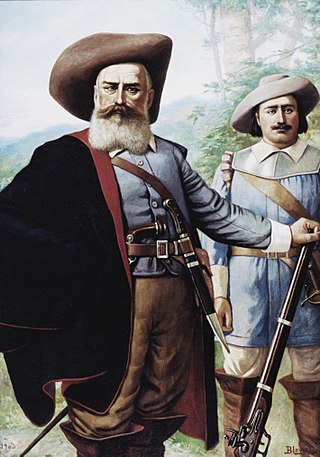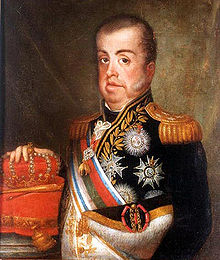
Alagoas, officially State of Alagoas, is one of the 27 federative units of Brazil and is situated in the eastern part of the Northeast Region. It borders: Pernambuco ; Sergipe (S); Bahia (SW); and the Atlantic Ocean (E). Its capital is the city of Maceió. It has 1.6% of the Brazilian population and produces 0.8% of the Brazilian GDP. It is made up of 102 municipalities and its most populous cities are Maceió, Arapiraca, Palmeira dos Índios, Rio Largo, Penedo, União dos Palmares, São Miguel dos Campos, Santana do Ipanema, Delmiro Gouveia, Coruripe, and Campo Alegre.

Maceió, formerly sometimes Anglicised as Maceio, is the capital and the largest city of the coastal state of Alagoas, Brazil. The name "Maceió" is an Indigenous term for a spring.

The Confederation of the Equator was a short-lived rebellion that occurred in the northeastern region of the Empire of Brazil in 1824, in the early years of the country's independence from Portugal. The secessionist movement was led by liberals who opposed the authoritarian and centralist policies of the nation's first leader, Emperor Pedro I. The fight occurred in the provinces of Pernambuco, Ceará and Paraíba.

Coqueiro Seco is a municipality located in the Brazilian state of Alagoas. Its population is 5,864 (2020) and its area is 40.4 km².

Domingos Jorge Velho was a Portuguese bandeirante. He was born in Santana de Parnaíba, captaincy of São Paulo, to Francisco Jorge Velho and Francisca Gonçalves de Camargo. He was responsible for the repression of several indigenous nations in Bahia and especially Piauí, which he is reputed to have been the first colonist to explore. His greater fame, however, is due to his conquest of the Quilombo dos Palmares, in the hinterland of Alagoas, on behalf of João da Cunha Souto Maior, governor of Pernambuco. Velho accepted the assignment and, in 1694, with an army of amerindians and mamelucos, European Native American offspring, overran the fortified city of Macacos, on the Serra da Barriga mountain.

The State of Brazil was one of the states of the Portuguese Empire, in the Americas during the period of Colonial Brazil.

Boris Fausto was a Brazilian historian, political scientist and writer.

Events in the year 1889 in Brazil.
Roberval Davino da Silva is a Brazilian football coach and former player who played as a midfielder. He is the current head coach of Paulista.

Events in the year 1996 in Brazil.

Anilda Neves Leão (1923–2012) was a Brazilian poet, writer, feminist, actress and singer. She was a member of numerous feminist organizations in Alagoas and attended the 1963 World Congress on Women in Moscow. She published her first volume of poems in 1961 and her last volume in 2002. She performed in theater and the burgeoning film industry in Alagoas, writing scripts and acting in both short films and features.

The Constituent Cortes of 1820, formal title The General and Extraordinary Cortes of the Portuguese Nation, also frequently known as the Sovereign Congress or the Cortes Constituintes Vintistas, was the first modern Portuguese parliament. Created after the Liberal Revolution of 1820 to prepare a constitution for Portugal and its overseas territories, it used a different system from the traditional General Cortes for choosing representatives, and the three traditional feudal estates no longer sat separately. The Cortes sat between January 24, 1821 and November 4, 1822 at the Necessidades Palace in Lisbon. The work of the Constitutional Cortes culminated in the approval of the Portuguese Constitution of 1822.

The history from the Brazilian state of Alagoas begins before the discovery of Brazil by the Portuguese, when the territory was inhabited by the Caeté people. The coast of the current state of Alagoas, recognized since the first Portuguese expeditions, was also visited early on by vessels of other nationalities for the barter of brazilwood.

The Captaincy of Paraíba was a Portuguese Empire overseas captaincy in Brazil created in 1574. However, it was only conquered more than a decade later with the supposed extinction of the Captaincy of Itamaracá in the second half of the 18th century, since it was originally part of French America and its fiefdoms, such as Forte Velho and Baía da Traição.

The Historic and Geographic Institute of Alagoas - IHGAL is a civil organization dedicated to the study and research in several fields of history, geography, and social sciences. It is located in downtown Maceió, in a building listed as a state heritage site. It was founded on December 2, 1869, and is the third oldest institution of its kind in Brazil.

The Dutch invasions in Brazil, ordered by the Dutch West India Company (WIC), occurred during the 17th century.

The history of Paraíba began before the discovery of Brazil, when the coastline of the state's current territory was populated by the Tabajara and Potiguara indigenous peoples. When the Portuguese arrived, the region was established as part of the Captaincy of Itamaracá. However, there were difficulties in implementing the Portuguese occupation fronts in the area, especially due to the resistance of the natives and the influence of French explorers, who used the coast of Paraíba for the illegal extraction of brazilwood.

The Captaincy of Alagoas was created on September 16, 1817, from the dismemberment of the Captaincy of Pernambuco. The capital was located in the current city of Marechal Deodoro under the name of Santa Maria Madalena da Lagoa do Sul.
The General Company of Pernambuco and Paraíba was a privileged monopoly company created by the Marquis of Pombal in the second half of the 18th century in Portugal.























